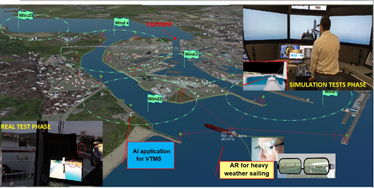

On 1st December 2023 was conducted a meeting of ILIAD Project partners TUV and BPIC under the heading “ILIAD – Technologies of the Future”. During the meeting was demonstrated the ongoing progress of the ILIAD Project and the jointly developed pilots and applications “Harbor Safety - Varna Port Pilot”, “I See Sea”. Also, current problems and unsolved tasks were discussed. Interested parties representatives, i.e. ship pilots, ship masters, sea business companies and potential end-users attended to the meeting as well.
At the beginning it was accentuated over the specific problem in Port of Varna, which should be solved by “Harbor Safety - Varna Port Pilot”, using the ILIAD DTO modeling technology and advancements. Afterwards the tasks achieved so far were demonstrated by both partners TUV and BPIC while co-working “Harbor Safety - Varna Port Pilot”. The pilot challenges when developing the DT models of Varna Bay and impact assessment of the used ILIAD technologies and innovations were taken into account.
The specific problem in Port of Varna, which should be solved by means of ILIAD DTO technology:
The extreme weather conditions in Varna Bay are a significant challenge for the operation of Port of Varna and safety navigation of ships in this area. During unfavorable meteorological conditions, especially fog, heavy rain or snowfall, BPIC experiences serious difficulties in vessel traffic management, thus hindering operations and leading to interruption of the vessel traffic to Varna Port and shipping channels connecting Varna Bay, Varna Lake and Beloslav Lake until weather permitting. On one hand, this leads to huge transport delays and financial losses for Port of Varna and local business. On the other hand, risk management activities should be performed including squalls, accidents, jelly-fish invasion and weather anomalies. The Jelly-fish makes problems to the staying at the ports vessels and yachts by getting stuck into the cooling valve, thus blocking the water circulation inside and control to the engine’s temperature and other machineries.
“Harbor Safety - Varna Port Pilot” challenges:
The development of Varna Bay DT and Port of Varna DT models aims to increase the number of days when Port of Varna and shipping channels to Varna Lake are open for navigation. This has economic and social benefits (no transport delays and financial losses for the Port of Varna and local business), as well as an ecology impact (reducing the carbon footprint of cargo vessels while staying at the roadstead of Varna Bay and waiting for the port to be operational).
Varna Bay DT and Port of Varna DT use AI technology for modelling and visualization of the sea area and coastline. Prototypes receive and process real-time data (filtering, adding missing values, consolidation by physical models, validation), gathered by the following sources:
1. BPI’s meteorological sensors network among the Black Sea coast, which during the ILIAD project is being upgraded by installing new sensors for measuring water currents. The new sensors are supplied by partner TalTech.
2. Signals and reports from citizens by the web application „I See Sea“ – wind direction and speed, temperature, visibility, dangers, unusual events, jelly fish invasion, oil spills, plastics or other types of pollution.
The practical application of Varna Bay DT in the already worked-out prototype Varna Port Pilot, was shown in two scenarios:
- Supporting vessel traffic management and navigation in Varna Bay and Port of Varna by predicting the wind speed and direction, water currents and specific for the location risk assessment.
At the moment AI-based instruments for local prediction of the weather are worked out, having a high time resolution, up to 3 hours in advance.
- Supporting ship’s „Blind Navigation“ during restricted visibility due to fog, heavy rain or snowfall - by using glasses with Advanced Reality (AR), ship pilots and ship masters will be assisted in ships handling during unfavorable weather conditions.
Tests with marine vessel have already being conducted in the navigational channels between Varna Lake and Varna Bay, using the AR-based technology.
During the second part of the meeting the partner TUV presented the software application “I See Sea”, aiming to promote the mission of Citizen Science in ILIAD project by using ILIAD DTO technologies. ILIAD mission under the logo „Let’s help Nature! Let’s contribute to the protection of the Black Sea Environment!” aims engaging in citizen science a society committed to marine environment problems, especially focusing on Varna Bay, including ecological, economical, social and technology instruments stimulating proactive citizens behavior.
Regarding this, a web system https://iliad.tu-varna.bg is being developed where registered users are able to send signals for pollution of the seawater or coast, jelly-fish invasion, changes in weather conditions or other unusual situations in the surrounding coastline. All the reports and signals from users will be visualized with their correct location over a digital map.
Other activities popularizing the ILIAD project in the scope of Citizen Science include Facebook page: /IliadTUV, investigation works, organizing seminars and events.
Finally, future joint actions were discussed, helping out in the real-time processing of data flows and the improvement of Varna Port Pilot prototype and DT models.



